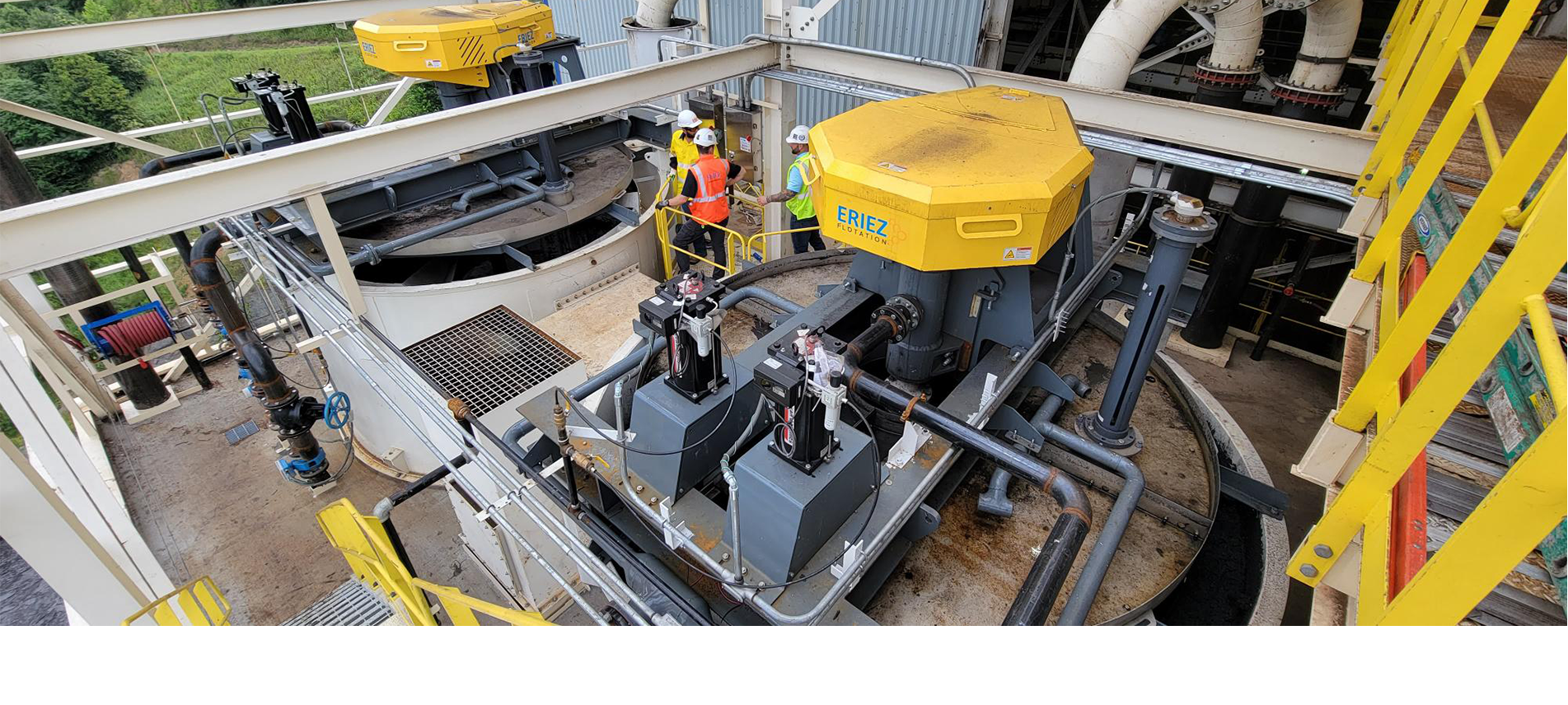
StackCell Flotation
StackCell High-Intensity Flotation
Superior metallurgical performance contributes to a more profitable and sustainable mining operation.
StackCell® flotation reduces the conventional flotation residence time requirement by 75 to 85% and increases the selective recovery of fine particles and slow-floating minerals, which increases profitability and improves the environmental sustainability of mining projects. For mining companies that want to minimize the environmental impacts of flotation circuits and maximize profitability, the StackCell offers reduced flotation circuit size and power consumption while delivering superior mineral recovery and concentrate grades.
Advantages
- Increase mill production and revenue
- Reduce carbon footprint and environmental impacts
- Increase project NPV
- Reduce CAPEX for greenfield projects and brownfield expansions
- Increase recovery of fine particles
- Increase concentrate grade
Product Highlights
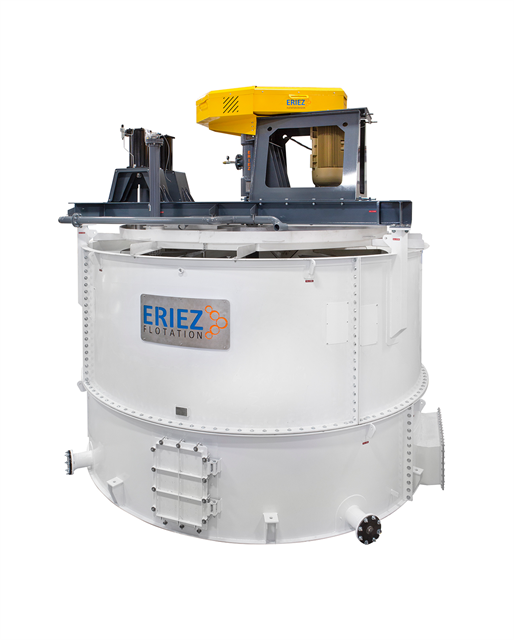
StackCell Advantages
StackCell Flotation increases profitability and improves the environmental sustainability of mining projects.
Increase Mill Production and Gross Revenue
- Maximize brownfield expansion throughput or increase recovery at present throughput within existing plant footprint with cells that are 20% of the size of conventional cells.
- Recover additional fines to concentrate that would otherwise be discarded to tailings.
Reduce Carbon Footprint and Environmental Impacts
- Reduced carbon footprint via reduced power consumption and smaller plant size with less concrete and steel requirements.
- Increased mine life at equivalent production level.
- Reduced fine tailings disposal from improved fines recovery.
Reduce CAPEX for Greenfield Projects and Brownfield Expansions
- Benchmarking against conventional stirred-tank flotation cells shows reduction in foundation loads of 70% and reduction of installation footprint and envelope of 50%.
Increase Project Net Present Value
- Lower TIC with reduced flotation plant footprint reduces payback period and improves project IRR/NPV.
- Higher recovery of fine particles generates increased revenues at equivalent processing rate.
Increase Recovery of Fine Particles
- Improved recovery of fine and slow floating particles.
Increase Concentrate Grade
- Increase flotation selectivity by rejecting entrained fine particles from concentrate froth.
- Flexibility to produce final concentrate in rougher stage.
Increase Production Capacity within Existing Plant Footprint
- Maximize use of existing plant footprint by adding 4-5 times recovery improvement in available space compared to conventional stirred-tank cells.
Product Features
Efficient and robust design features a high-turbulence bubble/particle contact chamber that feeds an external froth separation and recovery chamber.
The StackCell® high-rate flotation technology builds on the concept of focused energy input to enhance fine particle recovery and improve flotation kinetics over the full range of particle sizes. Through multiple full-scale installations and pilot-scale trials in base metals, the StackCell® has been proven to reduce flotation residence time requirement by 75 to 85 percent and increase fine particle recovery compared to conventional flotation cells.
The key feature of the StackCell is a high-turbulence contacting chamber that is isolated from a quiescent separation chamber, which allows for independent optimization of the particle collection process and the froth recovery process. In the StackCell, pulp and air are introduced to the bottom of the contacting chamber through the feed inlet and air inlet. The pulp and air are subjected to intense mixing while traveling up through the contacting chamber and the mixture is discharged into a quiescent separation chamber to allow for a phase separation to occur between the pulp and froth. The froth depth is maintained sufficiently deep to facilitate the use of counter-current wash water, thus minimizing the entrainment of fine hydrophilic particles.
This mechanism has an extremely high specific energy input that is converted to turbulent kinetic energy through the rotor blade design and generates 4-5 times higher turbulent dissipation rates as compared to conventional flotation machines. As a result, recovery of fine particles and slow floating minerals is increased, and flotation volumetric requirement is reduced.
The StackCell high-intensity flotation machine features a high-turbulence bubble/particle contact chamber with multi-stage rotor/stator mechanism that feeds an external froth separation and recovery chamber.
StackCell flotation machines are built to last, with components and electrical equipment selected for maximum availability and operating life.
Maintenance requirements and wear life consistent with conventional stirred-tank flotation cells.
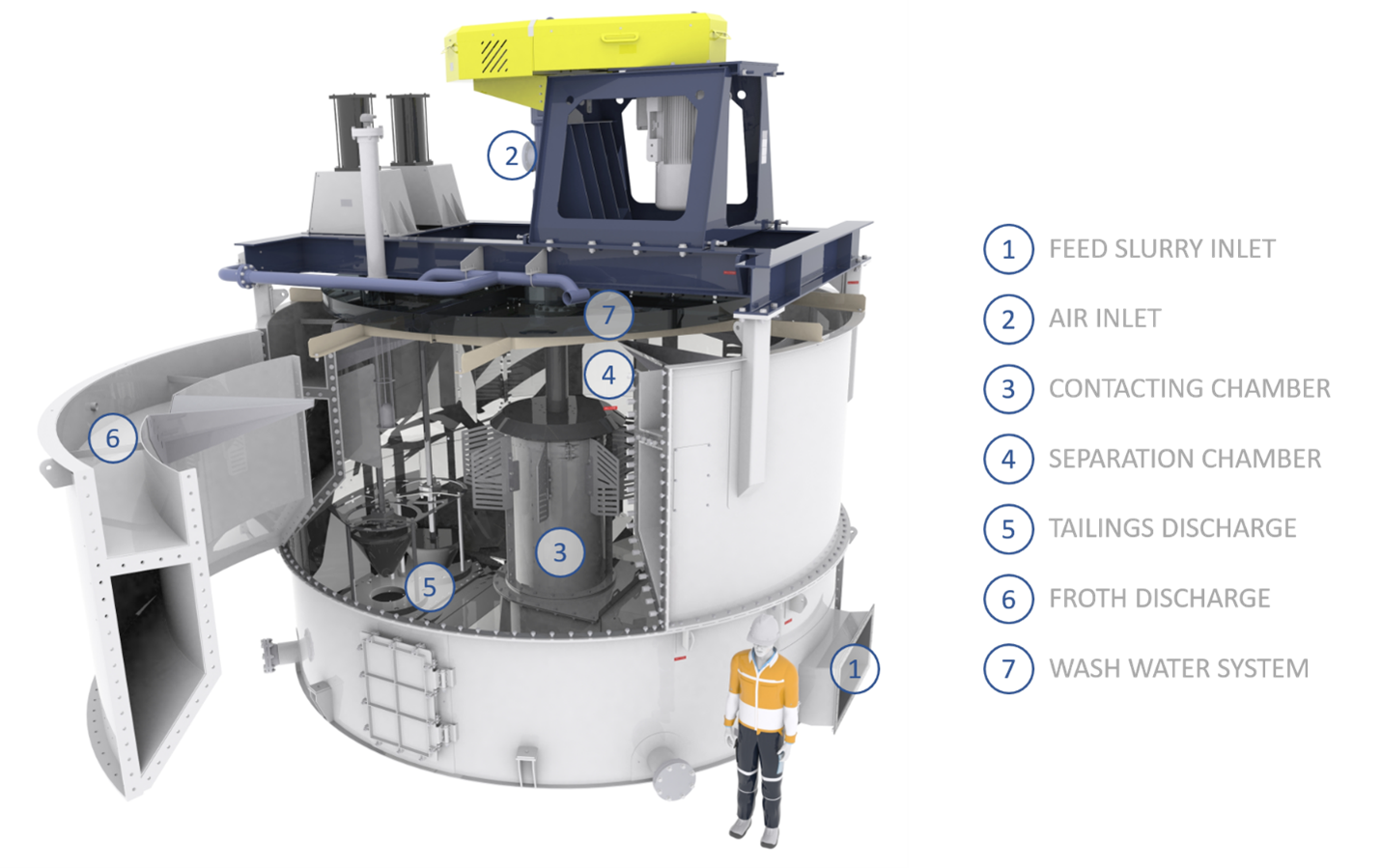
The StackCell achieves a 75-85% reduction in flotation residence time requirement by increasing the flotation rate constant of minerals through introduction of air and particles directly into the multi-stage rotor-stator mechanism within the contacting chamber.
The StackCell multi-stage rotor/stator mechanism generates strong shear layers in the wake region of slots near the suction side of the rotor blades. Large vortices in the shear layers interact and product micro-vortices similar in size to fine mineral particles. Micro-vortices increase the inertia of fine particles, which enables high collision rates and squeezing of liquid film between particles and air bubbles.
StackCell turbulent dissipation rates reach values up to 120 W/kg, which is nearly 5 times greater than the turbulence dissipation rate in the rotor/stator region of conventional flotation machines.
This improvement in turbulent dissipation rate in the StackCell contact chamber explains why the flotation rate constant in the StackCell® is roughly 4 to 5 times higher than conventional flotation machines.
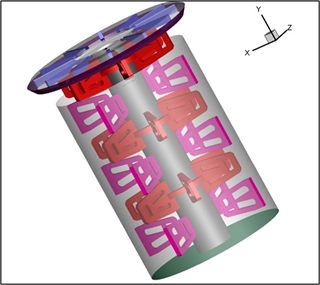
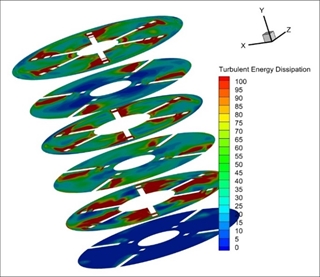
StackCell Turbulent Dissipation Rate
Mechanical Design and Reliability
StackCell design is engineered to minimize routine maintenance requirements. High-wear components life expectancy is 12-18 months.
A cast iron bearing housing design enables blower air introduction to the contact chamber through the shaft.
The rotating assembly consists of a motor and belt-drive assembly which drives shaft/rotor assembly.
Sectionalized components simplify transportation logistics, and plant site assembly as illustrated in the SC-200 Assembly Video.
High velocity areas including the contact chamber and lower shaft are lined with an elastomer to provide excellent wear characteristics
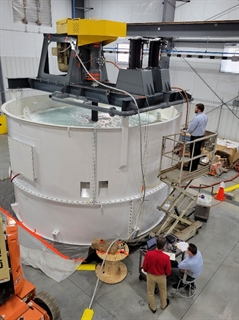
Product Line
Various standard cell sizes available to fit a wide range of mineral applications and duties.
StackCell naming convention identifies the equivalent conventional flotation capacity delivered by each StackCell unit. For example, a model SC-200 provides at minimum the equivalent flotation capacity as a 200 m3 conventional flotation cell
StackCell Product Line Summary
| Model | Installed Power (kW) | Air Rate Per Cell (Am3/hr) | Air Pressure At Shaft Inlet (kPag) |
|---|---|---|---|
| SC-20 | 15 | 80 | 34.5 |
| SC-50 | 55 | 600 | 34.5 |
| SC-70 | 55 | 1400 | 34.5 |
| SC-100 | 110 | 1400 | 34.5 |
| SC-200 | 110 | 1500 | 34.5 |
Installations
With operating units in Australia, North America, and South America and demonstrated excellence in a range of applications, the StackCell is proven to be efficient and reliable. Please contact your local Eriez Representative for an up-to-date StackCell Installation list.
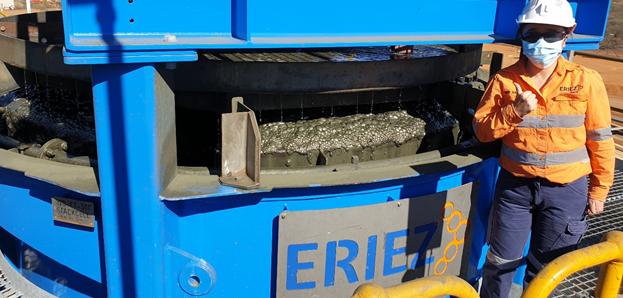
StackCell Flotation Animation
Eriez StackCell flotation machine decouples bubble-particle attachment and froth recovery. The attachment is optimized in a high-shear single-pass collection chamber, while froth recovery and concentrate grade are maximized in a separate quiescent flotation chamber. These high-rate, compact units offer considerable savings for new installations and are ideal for expanding capacity in an existing plant.
 Downloadable Documents
Downloadable Documents
![]()
Eriez StackCell - Delivering Superior Fine and Mid-Size Particle Recovery - StackCell delivers a step-change in flotation technology, unlocking fine and ultrafine particle recovery with a fraction of the energy, volume, and footprint. By decoupling the particle collection and phase separation zones, StackCell optimises flotation kinetics while minimising turbulence and entrainment in the separation chamber.
StackCell™: A new flotation technology for decreasing cost and increasing performance - Froth flotation is the most industrially significant process for upgrading a wide range of mineral systems. Most operating concentrators have a flotation line. The majority of these operations use mechanical tank cells for the lion’s share of the flotation requirements.
Benchmarking Performance of the Two-Stage StackCell™ with Conventional Flotation for Copper Sulfide Applications - Rougher flotation in sulfide ore applications is typically performed using conventional flotation machines. The trend over the last 100 years has been for these cells to become larger in volume with cells reaching sizes of 600 m3 and in some cases even larger.
Improving fine particle flotation using the StackCell™ (raising the tail of the elephant curve) - For decades, the conventional flotation machine has been the accepted tool for processing sulfide ores. As plant capacity increases, machine size has evolved to as much as 600 cubic meters to keep pace with the required retention times. However, the excessively large size of these machines requires extreme floor space, foundations and power to operate. Recent work conducted by Eriez has shown that high-efficiency flotation machines which are based on focused energy input can achieve similar results with significantly less retention time, floor space and power.
The Application of High Intensity Flotation Technology at Mt Keith Nickel Concentrator - Conventional flotation technology has historically failed to achieve high recoveries when treating <15 μm particles. The new StackCell™ flotation technology was developed to specifically target this particle size range, and was tested at pilot plant scale at Mt Keith Nickel Concentrator.
A high rate mechanical flotation cell for base metal applications - Mechanical cells are the dominant unit operation in base metal rougher flotation applications worldwide. As economic demand for metals increase, and as the feasible ore grades decrease, the installed capacity of mechanical flotation units worldwide has greatly increased, adding significant capital and operating cost. One opportunity to improve this situation is to use fundamental knowledge to make the industrial flotation process more efficient.
